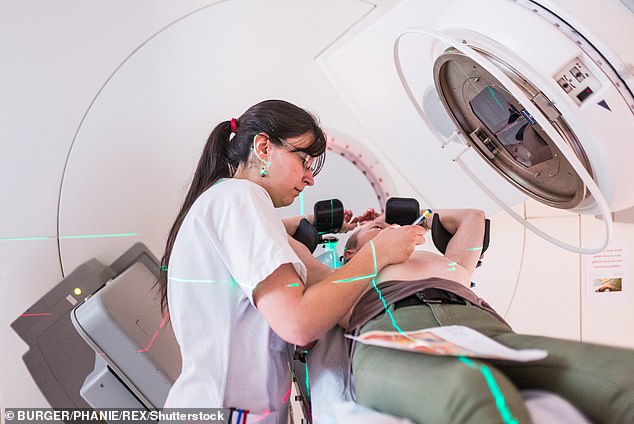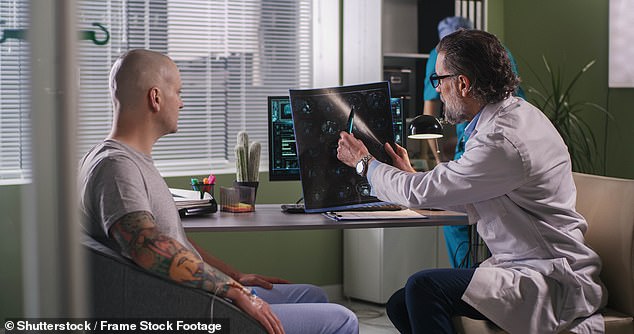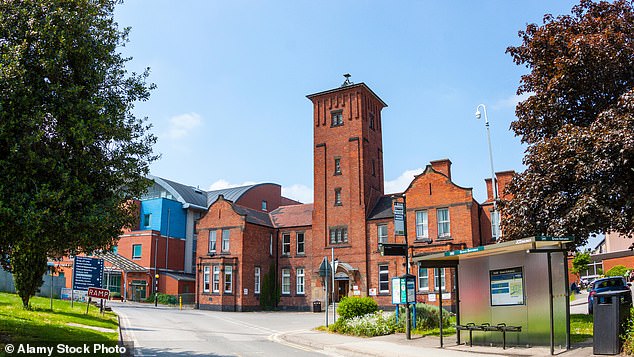A ‘Lollipop’ device that emits red light is being used to treat debilitating scars and swelling in the mouth caused by cancer treatment with radiotherapy.
The device’s light-emitting diodes (LEDs) can repair damaged tissue, calm the body’s response to injury and reduce inflammation, and patients simply need to put it in their mouth for a few minutes to feel the benefits.
The wavelength of light produced, called near-infrared, is believed to be absorbed by damaged cells and helps repair them.
The therapy, known as photobiomodulation, is being offered to NHS patients in Nottingham, where experts say it has proven remarkably successful. But there are now hopes it could be rolled out more widely in a bid to improve the lives of cancer survivors across the UK.
Radiation therapy usually involves shooting high-energy x-ray rays into the body to destroy tumors. The treatment is very effective, but there can be collateral damage to the surrounding healthy tissue, causing scars to appear both on the skin and inside.

Radiation therapy usually involves shooting high-energy x-ray beams into the body to destroy tumors. The treatment is very effective, but there can be collateral damage to healthy surrounding tissue, causing scarring both on the skin and internally (File photo)


The therapy, known as photobiomodulation, is being offered to NHS patients in Nottingham, where experts say it has proven remarkably successful. But there are now hopes it can be rolled out more widely in a bid to improve the lives of cancer survivors across the UK (File Photo).
Also known as fibrosis, it affects one in ten patients who undergo radiotherapy and the problem can appear months or even years after the initial treatment. It can cause discomfort and make it difficult to move the affected areas.
In the case of head and neck cancers, patients may be left unable to fully turn their head or, in the worst cases, unable to chew or speak properly.
LED treatment is already approved by the National Institute for Health and Care Excellence (NICE) to treat oral mucositis, a common side effect of radiotherapy or chemotherapy where the mouth is sore and swollen. It is also widely used to treat lymphedema, when parts of the body swell due to fluid retention.
But experts at the Macmillan Late Effects Clinic at Nottingham City Hospital, which supports patients experiencing serious difficulties following cancer treatment, are the first in the UK to use it to treat fibrosis.
Since 2022, about 120 patients with head and neck or breast cancer have been treated at the clinic for radiation-induced fibrosis and lymphedema using photobiomodulation therapy. Another accessory, shaped like a shower head, can be used if the scars are on the skin. Patients are medicated for a few minutes twice a week for six weeks, but can book further sessions if stiffness returns. Results are usually seen within a few weeks of the first treatment.
Cells are thought to absorb red light, which then sends chemical messages throughout the body to promote repair.
Unlike lasers, which emit heat, LEDs are cool to the touch, making the treatment painless.
Nottingham-based radiologist Emma Hallam, who runs the Late Effects Clinic, says she has seen photobiomodulation make an incredible difference to her patients’ lives. Some have been able to go back to work, give speeches at their children’s weddings, or eat solid food again, simply because they can open their mouths normally again.


Experts at the Macmillan Late Effects Clinic at Nottingham City Hospital (pictured), which supports patients experiencing serious difficulties following cancer treatment, are the first in the UK to use LED treatments to treat fibrosis.
She says: ‘I knew photobiomodulation was being used to help lymphoedema patients, so I wondered if it could also help break down radiation-induced fibrosis.
And it has been incredibly successful. It’s the only thing we seem to have that makes a difference for these patients.’
Cindy Martin, from Nottingham, has been receiving photobiomodulation treatment at the clinic since February 2022.
The 64-year-old mother of three was diagnosed with salivary gland cancer in early 2021. The tumor was surgically removed, but two months later she required a month-long radiotherapy treatment after the cancer spread to her glands. her neck.
This left her with fibrosis that made it difficult for her to move her head.
Cindy says: ‘I’m so grateful to have had radiotherapy, but I didn’t anticipate that I would still be suffering now. It was like there was a rod behind my ear to my shoulder blade.’
He also suffered from lymphedema, which caused one side of his face to swell so much that he had to close one eye.
Just halfway through her first photobiomodulation course, Cindy began to notice a difference and was able to open her eye once again. She began a second round of treatment a few weeks ago after the stiffness and swelling returned, and she soon experienced immediate improvement again.
“It has completely changed my life,” he adds, now cancer-free. “My confidence was shattered, but now I know there is something that can be done.”
